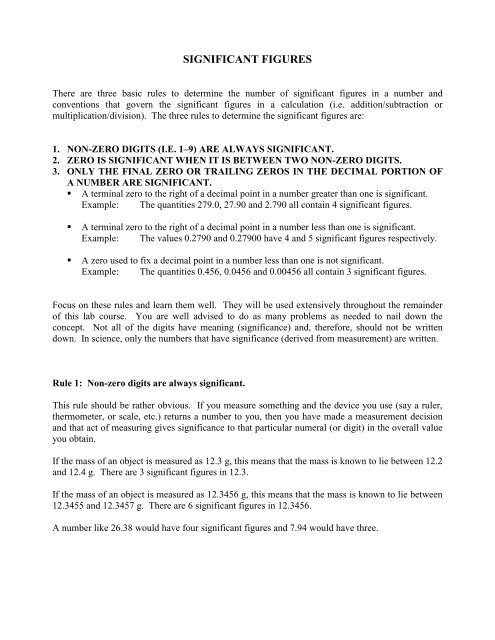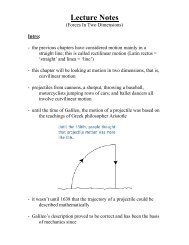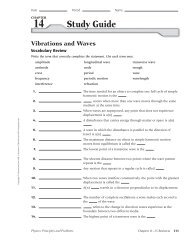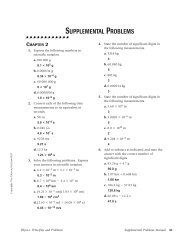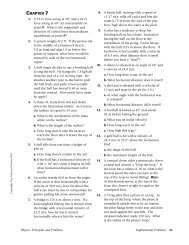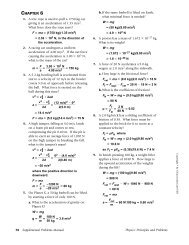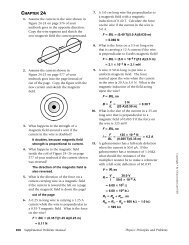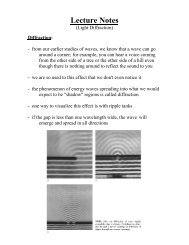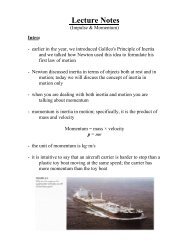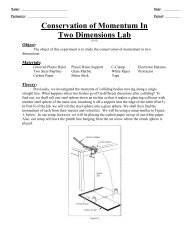SIGNIFICANT FIGURES - Dickey Physics
SIGNIFICANT FIGURES - Dickey Physics
SIGNIFICANT FIGURES - Dickey Physics
You also want an ePaper? Increase the reach of your titles
YUMPU automatically turns print PDFs into web optimized ePapers that Google loves.
<strong>SIGNIFICANT</strong> <strong>FIGURES</strong>There are three basic rules to determine the number of significant figures in a number andconventions that govern the significant figures in a calculation (i.e. addition/subtraction ormultiplication/division). The three rules to determine the significant figures are:1. NON-ZERO DIGITS (I.E. 1–9) ARE ALWAYS <strong>SIGNIFICANT</strong>.2. ZERO IS <strong>SIGNIFICANT</strong> WHEN IT IS BETWEEN TWO NON-ZERO DIGITS.3. ONLY THE FINAL ZERO OR TRAILING ZEROS IN THE DECIMAL PORTION OFA NUMBER ARE <strong>SIGNIFICANT</strong>.ƒA terminal zero to the right of a decimal point in a number greater than one is significant.Example: The quantities 279.0, 27.90 and 2.790 all contain 4 significant figures.ƒA terminal zero to the right of a decimal point in a number less than one is significant.Example: The values 0.2790 and 0.27900 have 4 and 5 significant figures respectively.ƒA zero used to fix a decimal point in a number less than one is not significant.Example: The quantities 0.456, 0.0456 and 0.00456 all contain 3 significant figures.Focus on these rules and learn them well. They will be used extensively throughout the remainderof this lab course. You are well advised to do as many problems as needed to nail down theconcept. Not all of the digits have meaning (significance) and, therefore, should not be writtendown. In science, only the numbers that have significance (derived from measurement) are written.Rule 1: Non-zero digits are always significant.This rule should be rather obvious. If you measure something and the device you use (say a ruler,thermometer, or scale, etc.) returns a number to you, then you have made a measurement decisionand that act of measuring gives significance to that particular numeral (or digit) in the overall valueyou obtain.If the mass of an object is measured as 12.3 g, this means that the mass is known to lie between 12.2and 12.4 g. There are 3 significant figures in 12.3.If the mass of an object is measured as 12.3456 g, this means that the mass is known to lie between12.3455 and 12.3457 g. There are 6 significant figures in 12.3456.A number like 26.38 would have four significant figures and 7.94 would have three.
Rule 2: Zero is significant when it is between two non-zero digits.Suppose you had a number like 406. By the first rule, the 4 and the 6 are significant. However, tomake a measurement decision on the 4 (in the hundred's place) and the 6 (in the unit's place), youmust make a decision on the ten's place. Therefore, the number 406 has 3 significant figures.The quantities 306, 30.6, 3.06 and 0.306 all contain 3 significant figures since the 0 between the 3and 6 is significant.Rule 3: Only the final zero or trailing zeros in the decimal portion of a number are significant.When a number like 0.00500 is written then the very first zero (to the left of the decimal point) isput there by convention. Its sole function is to communicate unambiguously that the decimal pointis a decimal point. If the number were written like this, .00500, there is a possibility that thedecimal point might be mistaken for a period. Many students omit that zero. They should not.This rule causes the most difficulty. Here are two examples of this rule where the significant zerosare in boldface:0.00500 3 significant figures 0.03040 4 significant figuresThe zeros between the decimal point and the non-zero digits serve only as space holders. They arethere to put the decimal point in its correct location. They DO NOT involve measurement decisions.Thus they are not significant. Upon writing the numbers in scientific notation (5.00 x 10¯3 and3.040 x 10¯2 ), the non-significant zeros disappear.Here are two more examples where the significant zeros are in boldface:2.30 x 10¯5 3 significant figures 4.500 x 10 12 4 significant figuresTrailing zeros in a whole number.The number 200 is considered to have only ONE significant figure while 25,000 has two.This is based on the way each number is written. When whole numbers are written as above, thezeros, by definition, did not require a measurement decision, thus they are not significant.However, it is entirely possible that the value 200 really does have two or three significant figures.If it does, it will be written in a different manner than 200. Typically, scientific notation is used forthis purpose. If 200 has two significant figures, then 2.0 x 10 2 is used. If it has three, then 2.00 x10 2 is used. If it had four, then 200.0 is sufficient.Leading zeros in a whole number.00250 has two significant figure and 005.00 x 10¯4 has three.
EXACT NUMBERSExact numbers, such as the number of people in a room, have an infinite number of significantfigures. Exact numbers are counting up how many of something are present; they are notmeasurements made with instruments. Another example of this are defined numbers, such as 1 foot= 12 inches. There are exactly 12 inches in one foot. Therefore, if a number is exact, it DOESNOT affect the accuracy of a calculation or the precision of the expression. Some more examples:There are 100 years in a century.2 molecules of hydrogen react with 1 molecule of oxygen to form 2 molecules of water.There are 500 sheets of paper in one ream.Interestingly, the speed of light is now a defined quantity. By definition, the value is 299,792,458meters per second.PRACTICE PROBLEMSIdentify the number of significant figures:1. 3.0800 - five significant figures.2. 0.00418 - three significant figures3. 7.09 x 10¯5 - three significant figures4. 91,600 - three significant figures5. 0.003005 - four significant figures6. 3.200 x 10 9 - four significant figures7. 250 - two significant figures8. 780,000,000 - two significant figures9. 0.0101 - three significant figures10. 0.00800 - three significant figures
MATHAMATICAL OPERATIONS WITH <strong>SIGNIFICANT</strong> <strong>FIGURES</strong>Products and QuotientsThe following rule or convention is used for expressing a computed product or quotient with theproper number of significant digits:THE PRODUCT OR QUOTIENT WILL BE REPORTED AS HAVING AS MANY<strong>SIGNIFICANT</strong> DIGITS AS THE NUMBER INVOLVED IN THE OPERATION WITH THELEAST NUMBER OF <strong>SIGNIFICANT</strong> DIGITS.For example: 0.000170 X 100.40The product could be expressed with no more than three significant digits since 0.000170 has onlythree significant digits, and 100.40 has five. So according to the rule the product answer could onlybe expressed with three significant digits.Sums and DifferencesThe rule for expressing a sum or difference is considerably different than the one for multiplicationor division. The rule expresses that the answer should have so many digits to the right of thedecimal instead of focusing in on the total number of significant digits as the other rule did. Again,the focus is upon the number of positions to the RIGHT of the decimal. This rule states:THE SUM OR DIFFERENCE CAN BE NO MORE PRECISE THAN THE LEASTPRECISE NUMBER INVOLVED IN THE MATHEMATICAL OPERATION.In other words the answer can have no more numbers to the right of the decimal than the numberinvolved in the operation with the least number of positions to the right of its decimal. Precisionhas to do with the number of positions to the RIGHT of the decimal. The more positions to theright of the decimal, the more precise the number. So a sum or difference can have no moreindicated positions to the right of the decimal as the number involved in the operation with theLEAST indicated positions to the right of it's decimal.For example:160.45 + 6.732 =167.182 Î 167.18The answer could be expressed to the nearest hundredths position since 160.45 is the least precise.Other examples include:45.621 + 4.3 - 6.41 = 43.5and17.142 + 2.0013 + 24.11 = 43.25
RULES FOR ROUNDINGOne other topic that needs to be covered is how do we round off non-essential digits according tothese rules. Although the rules should be well known at this level in your education they will bepresented for completeness. The set of conventional rules for rounding include:1. Determine what the last reported digit should be, according to the significant figure rulespresented above.2. Consider the digit to the right of the last reported digit.3. If the digit to the right of the last reported digit is less than 5 then leave the last reporteddigit unchanged and discard all digits to the right.4. If the digit to the right of the last reported digit is greater than 5 then increase the lastreported digit by one and discard all digits to its right.5. If the digit to the right of the last reported digit exactly 5 then add one to the reported digitif the reported digit is an odd number, and leave it unchanged if it is even.


